Submitted:
11 January 2024
Posted:
12 January 2024
You are already at the latest version
Abstract
Keywords:
1. Introduction
2. Methodology
2.1. Compositional Analysis of Cricket Flour
2.1.1. Humidity Determination
2.1.2. Ash content Determination
2.1.3. Fat content Determination
2.1.4. Protein Content Determination
2.1.5. Crude fiber CONTENT Determination
2.2. Sample Preparation
2.3. Chitin Extraction from Cricket Flour
2.3.1. Demineralization (DM)
2.3.2. Deproteinization (DP)
2.4. Purification and Bleaching Process
2.5. Deacetylation Process
2.6. Physicochemical Characterization Process of Chitin and Chitosan Obtained from Acheta Domesticus Cricket Flour
3. Results
3.1. Compositional Analysis of Cricket Flour
3.1.1. Humidity Determination
3.1.2. Ashes Determination
3.1.3. Fat Determination
3.1.4. Protein Determination
3.1.5. Crude Fiber Determination
3.2. Standarization of Demineralization Process
| Experimental condition |
HCl concentration [M] |
Time (h) | Temperature (ºC) |
Ash content (%) | %DM |
|---|---|---|---|---|---|
| 1 | 1 | 6 | 65 | 0.37 ± 0.03 | 92.1 ± 0.69 A, B, C, D |
| 2 | 1 | 3 | 30 | 0.47 ± 0.05 | 90.09 ± 0.98 B, C, D, E |
| 3 | 2 | 3 | 65 | 0.29 ± 0.11 | 93.86 ± 2.34 A |
| 4 | 1 | 3 | 65 | 0.53 ± 0.05 | 88.84 ± 1.08 D, E |
| 5 | 1 | 6 | 30 | 0.62 ± 0.06 | 86.79 ± 1.27 E |
| 6 | 2 | 6 | 30 | 0.49 ± 0.03 | 89.56 ± 0.59 C, D, E |
| 7 | 2 | 3 | 30 | 0.36 ± 0.03 | 92.25 ± 0.67 A, B, C |
| 8 | 2 | 6 | 65 | 0.33 ± 0.04 | 93.02 ± 0.92 A, B |
3.3. Optimization of Deproteinization Process
| Experimental condition |
NaOH concentration [M] |
Time (min) | Temperature (ºC) |
Protein (%) | DP (%) |
|---|---|---|---|---|---|
| 1 | 3 | 45 | 70 | 30.67 ± 3.63 | 44.08 ± 6.44 |
| 2 | 2 | 30 | 70 | 25.99 ± 1.84 | 52.61 ± 3.27 |
| 3 | 2 | 45 | 80 | 30.3 ± 0.08 | 44.76 ± 0.14 |
| 4 | 2 | 15 | 80 | 34.15 ± 0.3 | 37.73 ± 0.53 |
| 5 | 1 | 30 | 60 | 38.57 ± 1.69 | 29.69 ± 3.00 |
| 6 | 2 | 30 | 70 | 36.69 ± 2.11 | 33.11 ± 3.75 |
| 7 | 1 | 30 | 80 | 34.64 ± 0.31 | 36.84 ± 0.54 |
| 8 | 1 | 15 | 70 | 39.97 ± 0.88 | 27.13 ± 1.56 |
| 9 | 3 | 15 | 70 | 32.27 ± 1.97 | 41.16 ± 3.50 |
| 10 | 3 | 30 | 60 | 34.39 ± 0.97 | 37.31 ± 1.73 |
| 11 | 1 | 45 | 70 | 35.32 ± 0.72 | 35.6 ± 1.27 |
| 12 | 3 | 30 | 80 | 32.13 ± 2.88 | 41.42 ± 5.11 |
| 13 | 2 | 15 | 60 | 34.22 ± 0.38 | 37.62 ± 0.68 |
| 14 | 2 | 30 | 70 | 33.54 ± 4.07 | 38.84 ± 7.22 |
| 15 | 2 | 45 | 60 | 31.43 ± 2.98 | 42.7 ± 5.30 |
3.4. Chitin Bleaching
3.5. Deacetylation of Chitin and Obtention of Chitosan
3.6. Characterization of Chitin and Chitosan Extracted from Acheta Domesticus Cricket Flour
4. Discussion
4.1. Compositional Analysis of Cricket Flour
4.2. Standardization of Demineralization Process
4.3. Optimization of Deproteinization Process
4.4. Characterization: Identification of Chitin and Chitosan’s Functional Groups Using Fourier Transform Infrared Spectroscopy (FTIR)
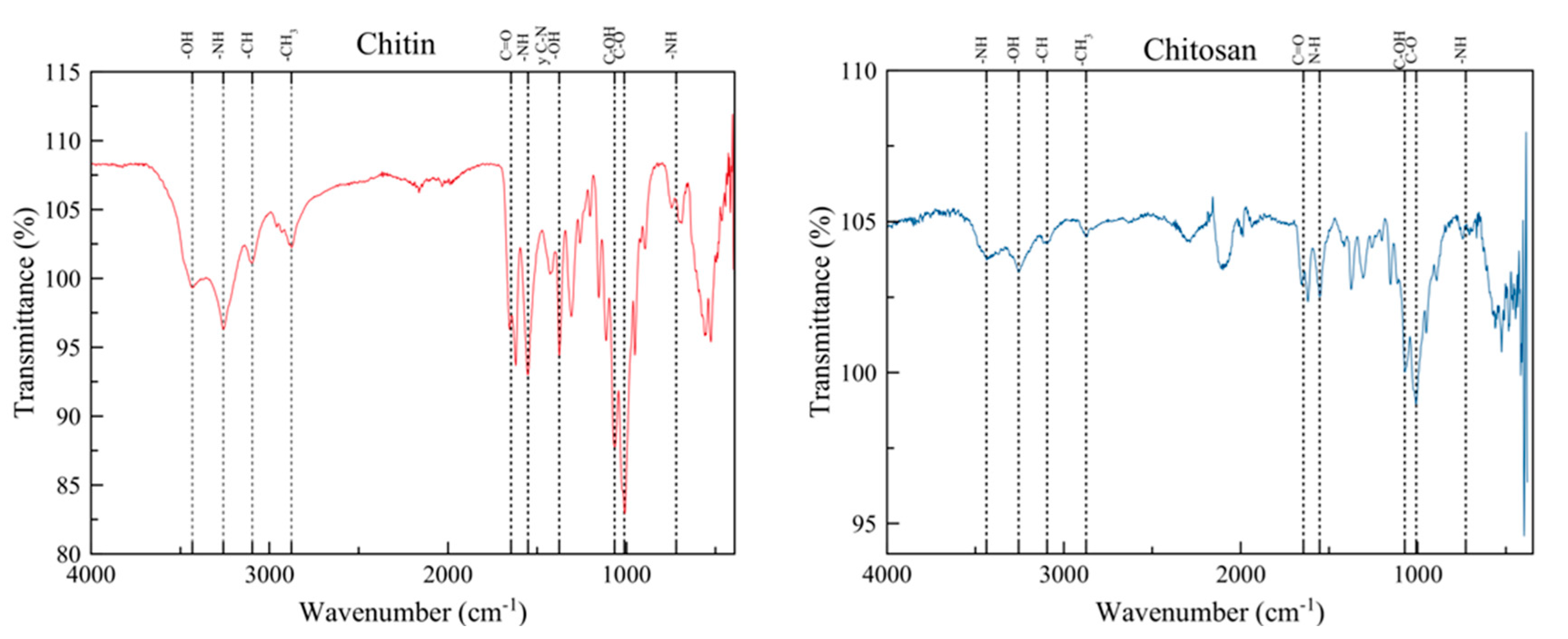
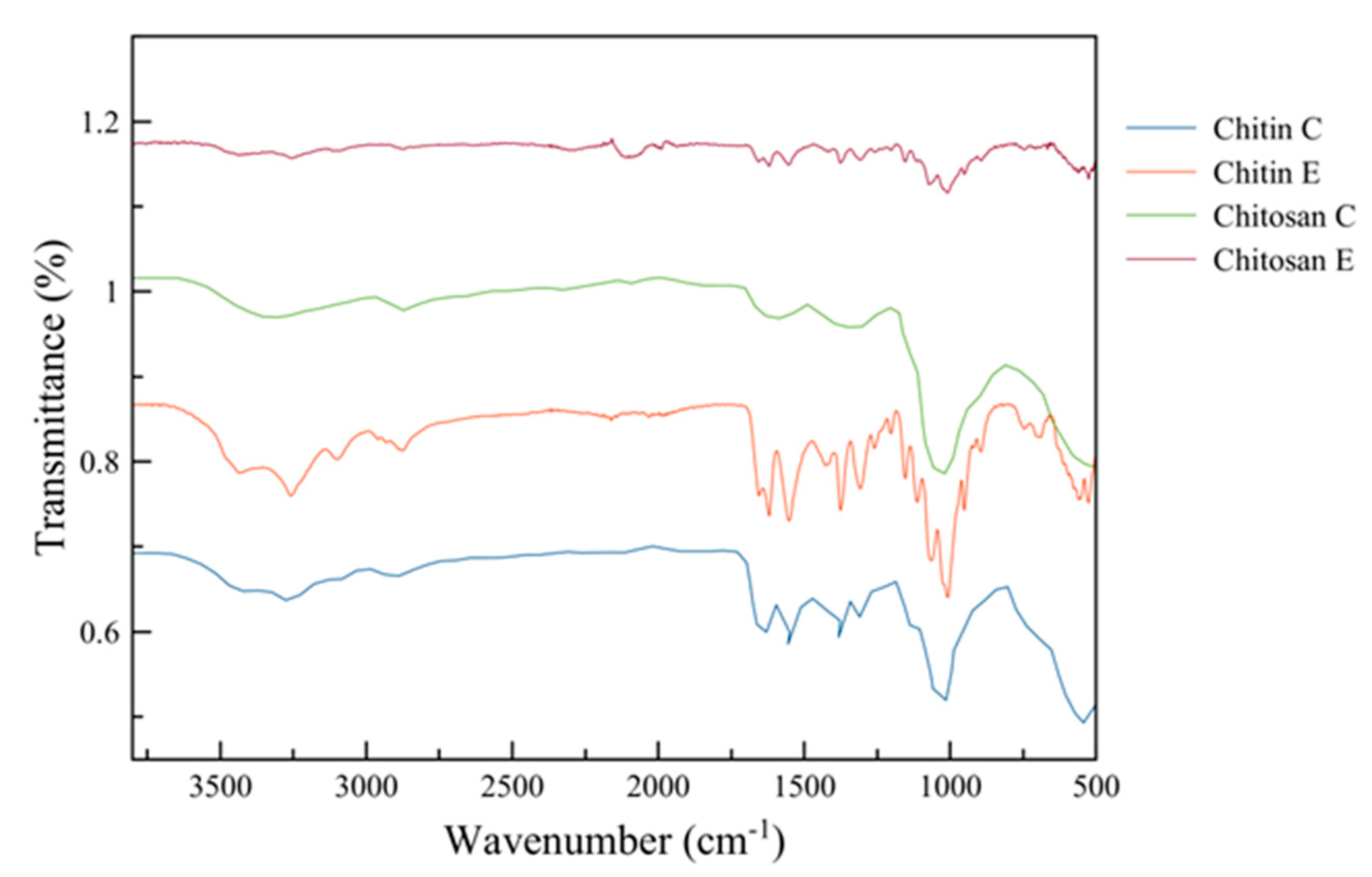
4.5. Characterization: Identification of Chitin and Chitosan’s Crystalline Structure Using X-Ray Diffraction (XRD)
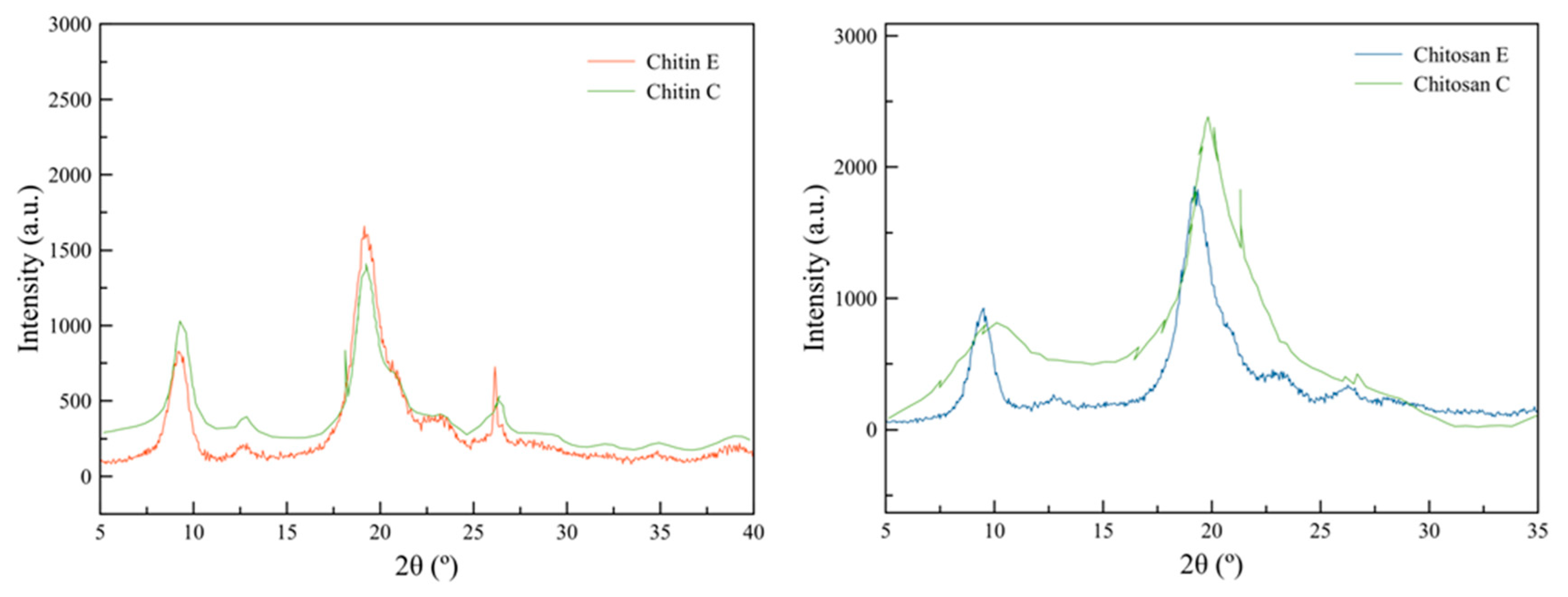
4.6. Morphology of Chitin and Chitosan Using Scanning Electron Microscopy (SEM)
4.7. Characterization: Analysis of Chitin and Chitosan Thermal Behaviour Using Differential Scanning Calorimetry (DSC)
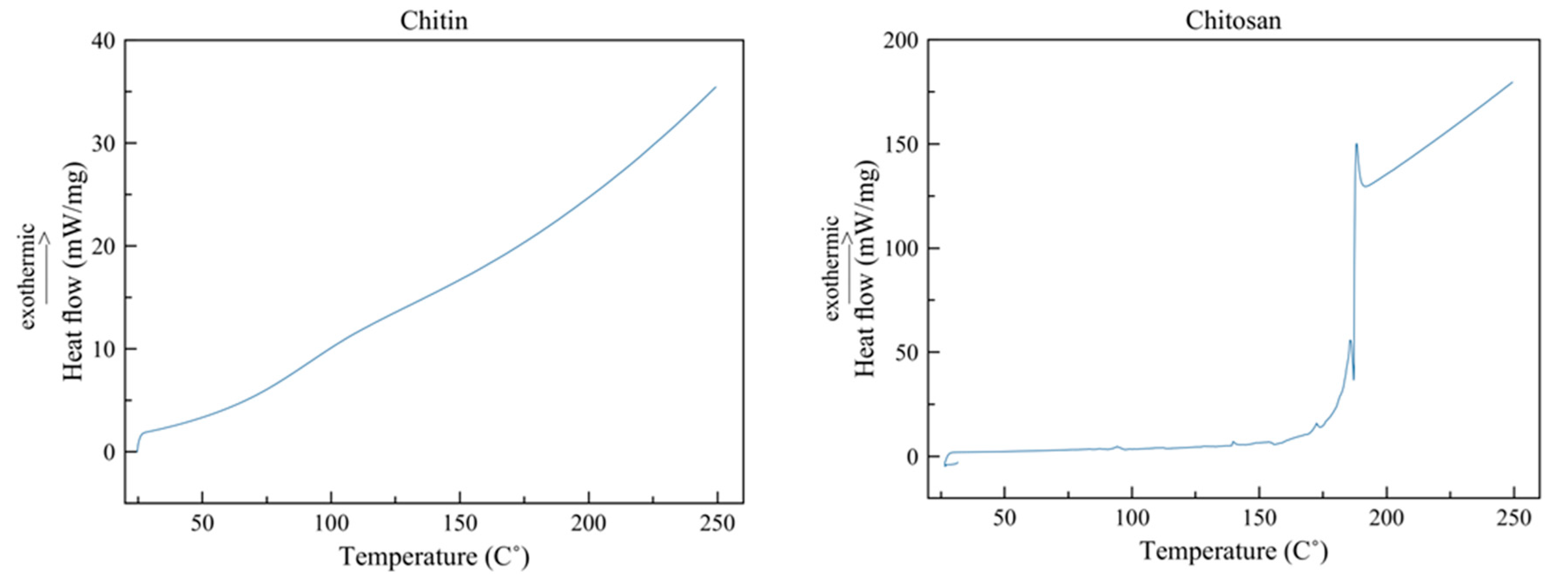
5. Conclusions
Author Contributions
Funding
Data Availability Statement
Acknowledgments
Conflicts of Interest
References
- Knidri, H.E.; Belaabed, R.; Addaou, A.; Laajeb, A.; Lahsini, A. Extraction, chemical modification and characterization of chitin and chitosan. Int. J. Biol. Macromol. 2018, 120, 1181–1189. [Google Scholar] [CrossRef]
- Iber, B.T.; Kasan, N.A.; Torsabo, D.; Omuwa, J.W. A review of various sources of chitin and chitosan in nature. J. Renew. Mater. 2022, 10, 1097–1123. [Google Scholar] [CrossRef]
- Mohan, K.; Ganesan, A.R.; Muralisankar, T.; Jayakumar, R.; Sathishkumar, P.; Uthayakumar, V.; Revathi, N. Recent insights into the extraction, characterization, and bioactivities of chitin and chitosan from insects. Trends Food Sci. Technol. 2020, 105, 17–42. [Google Scholar] [CrossRef] [PubMed]
- Monter-Miranda, J.G.; Tirado-Gallegos, J.M.; Zamudio-Flores, P.B.; Rios-Velasco, C.; Ornelas-Paz, J.D.J.; Salgado-Delgado, R.; Hernández-Centeno, F. Extracción y caracterización de propiedades fisicoquímicas, morfológicas y estructurales de quitina y quitosano de Brachystola magna (Girard). Rev. Mex. Ing. Quim. 2016, 15, 749–761. [Google Scholar] [CrossRef]
- Kumari, S.; Kishor, R. Chitin and chitosan: origin, properties, and applications. In Handbook of chitin and chitosan, 1st ed.; Gopi, S., Thomas, S. Pius, Eds.; Elsevier: Amsterdam, The Netherlands, 2020; pp. 1–33. [Google Scholar] [CrossRef]
- Hahn, T.; Tafi, E.; Paul, A.; Salvia, R.; Falabella, P.; Zibek, S. Current state of chitin purification and chitosan production from insects. J. Chem. Technol. Biotechnol. 2020, 95, 2775–2795. [Google Scholar] [CrossRef]
- Luo, Q.; Wang, Y.; Han, Q.; Ji, L.; Zhang, H.; Fei, Z.; Wang, Y. Comparison of the physicochemical, rheological, and morphologic properties of chitosan from four insects. Carbohydr. Polym. 2019, 209, 266–275. [Google Scholar] [CrossRef]
- Kaya, M.; Bağrıaçık, N.; Seyyar, O.; Baran, T. Comparison of chitin structures derived from three common wasp species (Vespa crabro Linnaeus, 1758, Vespa orientalis Linnaeus, 1771 and Vespula germanica (Fabricius, 1793). Arch. insect Biochem. Physiol. 2015, 89, 204–217. [Google Scholar] [CrossRef]
- Kaya, M.; Bitim, B.; Mujtaba, M.; Koyuncu, T. Surface morphology of chitin highly related with the isolated body part of butterfly (Argynnis pandora). Int. J. Biol. Macromol. 2015, 81, 443–449. [Google Scholar] [CrossRef]
- Amoo, K.O.; Olafadehan, O.A.; Ajayi, T.O. Optimization studies of chitin and chitosan production from Penaeus notialis shell waste. Afr. J. Biotechnol. 2019, 18, 670–688. [Google Scholar] [CrossRef]
- Ovando, E.; Rodríguez-Sifuentes, L.; Martínez, L.M.; Chuck-Hernández, C. Optimization of soybean protein extraction using by-products from NaCl electrolysis as an application of the industrial symbiosis concept. Appl. Sci. 2022 12, 3113. [CrossRef]
- Dar, M.A.; Kaushik, G. Optimization of process parameters for biodegradation of malathion by Micrococcus aloeverae MAGK3 using taguchi methodology and metabolic pathway analysis. Biocatal. Agric. Biotechnol. 2022, 42, 102362. [Google Scholar] [CrossRef]
- Lahiri, D.; Nag, M.; Sarkar, T.; Dutta, B.; Ray, R.R. Antibiofilm activity of α-amylase from Bacillus subtilis and prediction of the optimized conditions for biofilm removal by response surface methodology (RSM) and artificial neural network (ANN). Appl. Biochem. Biotechnol. 2022, 193, 1853–1872. [Google Scholar] [CrossRef] [PubMed]
- Sierra, D.M.E.; Orozco, C.P.O.; Rodríguez, M.A.Q.; Villa, W.A.O. Optimización de un protocolo de extracción de quitina y quitosano desde caparazones de crustáceos. Sci. Tech. 2013, 18, 260–266. [Google Scholar] [CrossRef]
- Tokatlı, K.; Demirdöven, A. Optimization of chitin and chitosan production from shrimp wastes and characterization. J. Food process. Preserv. 2018, 42, e13494. [Google Scholar] [CrossRef]
- Gîjiu, C.L.; Isopescu, R.; Dinculescu, D.; Memecică, M.; Apetroaei, M.R.; Anton, M.; Rău, I. Crabs marine waste—a valuable source of chitosan: tuning chitosan properties by chitin extraction optimization. Polymers 2022, 14, 4492. [Google Scholar] [CrossRef] [PubMed]
- Dinculescu, D.; Gîjiu, C.L.; Apetroaei, M.R.; Isopescu, R.; Rău, I.; Schröder, V. Optimization of chitosan extraction process from Rapana venosa egg capsules waste using experimental design. Materials 2023, 16, 525. [Google Scholar] [CrossRef]
- Pădurețu, C.C.; Isopescu, R.D.; Gîjiu, C.L.; Rău, I.; Apetroaei, M.R.; Schröder, V. Optimization of chitin extraction procedure from shrimp waste using Taguchi method and chitosan characterization. Mol. Crys. Liq. Crys. 2019, 695, 19–28. [Google Scholar] [CrossRef]
- Dong, F.; Qiu, H.; Jia, S.; Dai, C.; Kong, Q.; Xu, C. Optimization of extraction of chitin from procambarus clarkia shell by Box-Behnken design. 4th International Conference on Energy Materials and Environment Engineering (ICEMEE 2018). Zhuhai, China, September 28–30 2018; E3S Web of Conferences 38, 02010 (2018). Page 5. 28 September.
- AOAC Official Method 934.06. Moisture in dried fruits. Rockville, MD, USA: AOAC International. 1996.
- AOAC 923.03 Ashes. Available on line: https://law.resource.org/pub/us/cfr/ibr/002/aoac.methods.1.1990.pdf. (Accessed: Nov. 25, 2023).
- AACC. International Approved Methods of the American Association of Cereal Chemists; Minnesota University Press: St. Paul, MN, USA, 2000. [Google Scholar]
- AOAC Official Method 984.13. Protein (crude) in animal feed and pet food. Rockville, MD, USA: AOAC International. 1996.
- NOM-Y-118-A-1982 Determinación de proteína. Available on line: https://www.dof.gob.mx/nota_detalle.php?codigo=4790976&fecha=04/01/1983#gsc.tab=0 (Accessed: Nov. 28, 2023).
- NOM-F-90-S-1978 Determinación de Fibra Cruda en Alimentos. Available on line: https://www.dof.gob.mx/nota_detalle.php?codigo=4799842&fecha=27/03/1979#gsc.tab=0 (Accessed: Nov. 25, 2023).
- AOAC Official method 962.09. Crude fiber in animal feed. MD, USA: AOAC International. 2005.
- Ibitoye, E.B.; Lokman, I.H.; Hezmee, M.N.M.; Goh, Y.M.; Zuki, A.B.Z.; Jimoh, A.A. Extraction and physicochemical characterization of chitin and chitosan isolated from house cricket. Biomed. Mater. 2018, 13, 025009. [Google Scholar] [CrossRef]
- Nielsen, S.S. Food analysis laboratory manual, 3rd ed.; Kluwer Academic/Plenum Publishers: New York, NY, USA, 2003; p. 557. [Google Scholar]
- Udomsil, N.; Imsoonthornruksa, S.; Gosalawit, C.; Ketudat-Cairns, M. Nutritional values and functional properties of house cricket (Acheta domesticus) and field cricket (Gryllus bimaculatus). Food Sci.Technol.Res. 2019, 25, 597–605. [Google Scholar] [CrossRef]
- Boulos, S.; Tännler, A.; Nyström, L. Nitrogen-to-protein conversion factors for edible insects on the Swiss market: T. molitor, A. domesticus, and L. migratoria. Front Nutr. 2020, 7, 89. [Google Scholar] [CrossRef]
- AOAC. Official Methods of Analysis, 21st ed.; AOAC International: Gaithersburg, MD, USA, 2019. [Google Scholar]
- Hahn, T.; Tafi, E.; Paul, A.; Salvia, R.; Falabella, P.; Zibek, S. Current state of chitin purification and chitosan production from insects. J. Chem. Technol. Biotechnol. 2020, 95, 2775–2795. [Google Scholar] [CrossRef]
- Bawa, M.; Songsermpong, S.; Kaewtapee, C.; Chanput, W. Effect of diet on the growth performance, feed conversion, and nutrient content of the house cricket. J. Insect Sci. 2020, 20, 10. [Google Scholar] [CrossRef] [PubMed]
- Psarianos, M.; Ojha, S.; Schneider, R.; Schlüter, O.K. Chitin isolation and chitosan production from house crickets (Acheta domesticus) by environmentally friendly methods. Molecules 2022, 27, 5005. [Google Scholar] [CrossRef] [PubMed]
- Zainol Abidin, N.A.; Kormin, F.; Zainol Abidin, N.A.; Mohamed Anuar, N.A.F.; Abu Bakar, M.F. The potential of insects as alternative sources of chitin: An overview on the chemical method of extraction from various sources. Int. J. Mol. Sci. 2020, 21, 4978. [Google Scholar] [CrossRef]
- Moreno Villa, F.A. Obtención de glucosamina hidroclorada (GIcHCI) a partir de la hidrólisis ácida de quitina y quitosano extraidos de desecho de jaiba (Callinectes arcuatus). Master's thesis. Universidad de Sonora. Hermosillo, Sonora, México, June 30th, 2010.
- Lerma, A.G.V. Modificación estructural de quitina mediante métodos físicos y químicos para su hidrólisis enzimática mediante quitinasas de Lecanicillium lecanii. Doctoral thesis. Universidad Autónoma Metropolitana. Ciudad de México, México, January 23rd, 2015.
- Chen, J.K.; Shen, C.R.; Liu, C.L. N-acetylglucosamine: production and applications. Mar. Drugs. 2010, 8, 2493–2516. [Google Scholar] [CrossRef] [PubMed]
- Faraldos, M.; Goberna, C. Técnicas de análisis y caracterización de materiales, 3rd ed.; Consejo Superior de Investigaciones Científicas: Madrid, Spain, 2021; p. 1052. [Google Scholar]
- Pungor, E.; Horvai, G. A practical guide to instrumental analysis, 1st ed.; CRC press: Boca Raton, London, N.Y., USA, 2020; p. 288. [Google Scholar]
- Dahmane, E.M.; Taourirte, M.; Eladlani, N.; Rhazi, M. Extraction and characterization of chitin and chitosan from Parapenaeus longirostris from Moroccan local sources. Int. J. Polym. Anal. Charact. 2014, 19, 342–351. [Google Scholar] [CrossRef]
- Mohan, K.; Ganesan, A.R.; Muralisankar, T.; Jayakumar, R.; Sathishkumar, P.; Uthayakumar, V.; Revathi, N. Recent insights into the extraction, characterization, and bioactivities of chitin and chitosan from insects. Trends Food Sci. Technol. 2020, 105, 17–42. [Google Scholar] [CrossRef] [PubMed]
- Majtán, J.; Bíliková, K.; Markovič, O.; Gróf, J.; Kogan, G.; Šimúth, J. Isolation and characterization of chitin from bumblebee (Bombus terrestris). Int. J. Biol. Macromol. 2007, 40, 237–241. [Google Scholar] [CrossRef]
- Sáenz-Mendoza, A.; Zamudio-Flores, P.B.; Palomino-Artalejo, G.A.; Tirado-Gallegos, J.M.; García-Cano, V.G.; Ornelas-Paz, J.J.; Aparicio-Saguilán, A. Physicochemical, morphological and structural characterization of the chitin and chitosan of Tenebrio molitor and Galleria mellonella insects. Rev. Mex. Ing. Quim. 2019, 18, 39–56. [Google Scholar] [CrossRef]
- Martínez, C.M.P. Los fundamentos de la cristalografía: una reseña histórica. An. Quím. 2014, 4, 294–302. [Google Scholar]
- Ameh, E.S. A review of basic crystallography and x-ray diffraction applications. Int. J. Adv. Manuf. Technol. 2019, 105, 3289–3302. [Google Scholar] [CrossRef]
- Mohan, K.; Muralisankar, T.; Jayakumar, R.; Rajeevgandhi, C. A study on structural comparisons of α-chitin extracted from marine crustacean shell waste. Carbohydr. Polym. Technol. Appl. 2021, 2, 100037. [Google Scholar] [CrossRef]
- Kaya, M.; Lelešius, E.; Nagrockaitė, R.; Sargin, I.; Arslan, G.; Mol, A.; Bitim, B. Differentiations of chitin content and surface morphologies of chitins extracted from male and female grasshopper species. PloS One. 2015, 10, e0115531. [Google Scholar] [CrossRef] [PubMed]
- Penagos, J.I.C. Caracterización de materiales a través de medidas de microscopía electrónica de barrido (SEM). Elementos 2013, 3, 133–146. [Google Scholar]
- Rojas, J.; Ciro, Y.; Salamanca, C. Efecto del grado de acetilación en las propiedades farmacocinéticas de quitina extraída de exoesqueletos de camarones. Vitae 2018, 25, 87. [Google Scholar]
- Guinesi, L.S.; Cavalheiro, É.T. G. The use of DSC curves to determine the acetylation degree of chitin/chitosan samples. Thermochim. Acta 2006, 444, 128–133. [Google Scholar] [CrossRef]

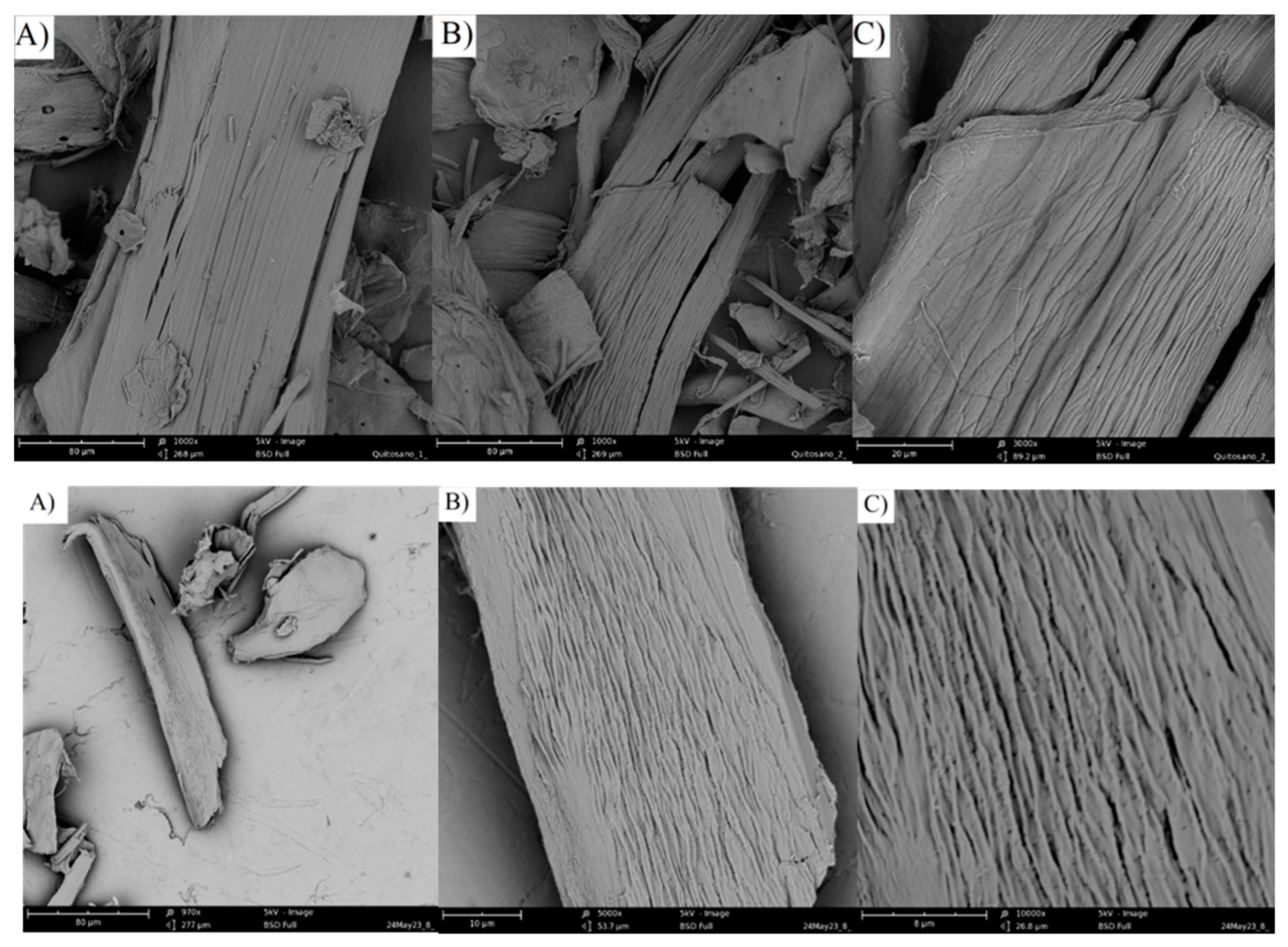
| Analysis | Wet base (%) | Dry base (%) | Udomsil et al. [29] (%) |
|---|---|---|---|
| Humidity | 2.55 ± 0.11 | - | 6.3 ± 0.04 |
| Fat | 13.01 ± 0.65 | 13.35 ± 0.65 | 10.4 ± 0.1 |
| Ashes | 4.19 ± 0.04 | 4.30 ± 0.04 | 5.4 ± 0.3 |
| Protein | 54.85 ± 0.69 | 56.29 ± 0.69 | 71.7 ± 0.5 |
| Crude fiber | 15.31 ± 1.01 | 15.71 ± 1.01 | 4.6 ± 0.2 |
| Carbohydrates | 25.40 | 26.06 | 1.6 |
| Factor | Levels | Values | P-Value (α = 0.05) |
|---|---|---|---|
| Time (h) | 1 | 3 | 0.230 |
| 2 | 6 | ||
| Temperature (ºC) | 1 | 30 | 0.005 |
| 2 | 60 | ||
| Concentration (M) | 1 | 1 | 0.001 |
| 2 | 2 |
| Factor | P-Value (α = 0.05) |
|---|---|
| Temperature (ºC) | 0.119 |
| Time (hrs) | 0.009 |
| Concentration OH (M) | 0.000 |
| Concentration OH * Concentration OH | 0.019 |
Disclaimer/Publisher’s Note: The statements, opinions and data contained in all publications are solely those of the individual author(s) and contributor(s) and not of MDPI and/or the editor(s). MDPI and/or the editor(s) disclaim responsibility for any injury to people or property resulting from any ideas, methods, instructions or products referred to in the content. |
© 2024 by the authors. Licensee MDPI, Basel, Switzerland. This article is an open access article distributed under the terms and conditions of the Creative Commons Attribution (CC BY) license (http://creativecommons.org/licenses/by/4.0/).





